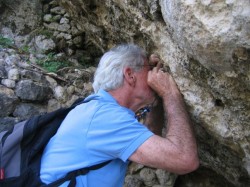Volcanologist at Large

Professor Floyd McCoy explores a geological feature.
The fourth year of the Malcom H. Wiener Visiting Research Professorship passed this academic year; four years where the ASCSA mixes into an already wonderful brew of historians, philologists, archaeologists, classicists, and others, a collection of scientists. That mix has so far incorporated an anthropologist specializing in human bones, a ceramicist focused on pottery fabrics and clays, and a chemist interested in the mineralogy of pigments used in antiquity. This past year a volcanologist was added. And that volcanologist (a grayhead among Whiteheads) came planning a grand year to see four papers finished, laboratory work done, plus a book written and perhaps even finished, in addition to whatever came with the professorship. Here is what really happened:
First there were the field trips. Under both Prof. John Oakley (NE and Central Greece; NW and Central Greece), and Dr. Bob Bridges (Crete) these were a terrific entry for this geologist into history and prehistory. Add to that the day trips, a presentation at the Fitch-Wiener Lab Seminar Series, a Wiener Lab workshop, and Fulbright obligations (in conjunction with my award as a Fulbright Senior Scholar) . . . that was the fall term. Winter/Spring brought the seminar series, mine on “Catastrophism in the Archaeological and Historic Record” that attracted not only ASCSA students, but others from foreign schools and the University of Athens. Add to that lecturing at the Canadian Institute and to visiting groups to the ASCSA, organizing a field trip to Santorini (done in by strong winds and rain), returning to Santorini to shoot yet another segment of a television special, more day trips, and then the Malta field trip . . . that was the winter and spring term.
Best of all were the students, a remarkably smart, funny, resilient group (ask them about the unexpected all-night bus trip from Kevala to Athens) that taught me so much more than I could contribute (ask them about this geologist’s silly questions at sites).
Professional work did get accomplished and included a meeting on Santorini concerned with massive submarine slides and avalanches, a meeting in Denmark discussing the dating difficulties for the Late Bronze Age (LBA) eruption of Santorini, lecturing to a National Geographic group on their cruise ship in the Santorini caldera, attending lectures everywhere, and a few other interesting experiences that kept me from ouzo hour.
Papers did get finished. The book, however, remains undone. Yet the book is difficult to complete because of new discoveries on my favorite research item (and prospective book), the LBA eruption of Santorini. New finds of tephra from that eruption on Crete make clear that this event was far larger than we had considered. Computer modeling of tsunami from that event, done by a Wiener Lab Associate two years ago, indicates waves up to 26 m (that’s close to 86 feet) with inundation along selected areas of north Crete up to 200 m (660 feet) inland. Then came the astonishing find of sedimentary deposits off Israel that date to the LBA, interpreted as tsunami deposits, this layer equally thick as an overlying deposit dated to the A.D. 551 earthquake that ruined the harbor at Ceasarea Maritima. The implication is of a damaging tsunami produced during the LBA eruption throughout the eastern Mediterranean far from its Aegean source. And afield from volcanoes were studies on Crete concerning modern atmospheric conditions within Skoteino cave and possible implications on cave use in prehistory; on Minoan hydrologic constructions and quarries; as well as deep-water surveys mapping sea floor geology and archaeology south of Crete.
It was an exciting and wonderful year for listening, learning, teaching and research. And it was particularly rewarding to help integrate the Wiener Laboratory into the fabric of the ASCSA, none of which could have been accomplished without the guidance and friendship of Dr. Sherry Fox, Wiener Laboratory director.
Floyd McCoy